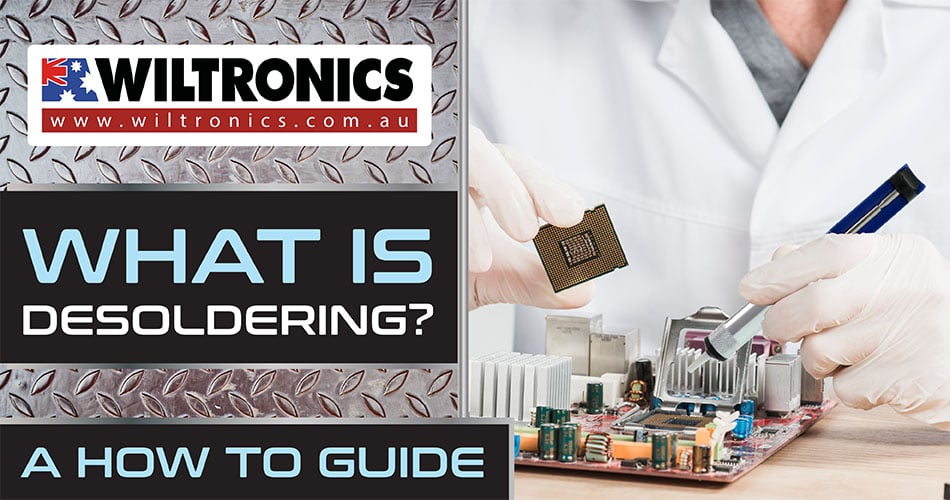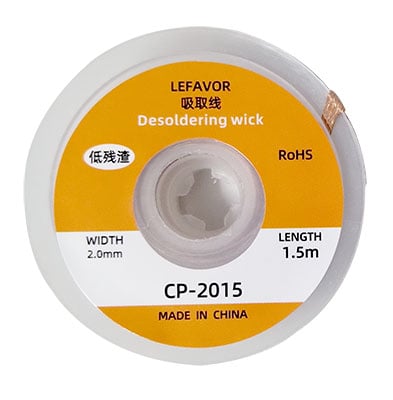A How-to Guide for Basic Desoldering: What Is Desoldering?
March 1, 2022

You may have heard of soldering before, but ‘desoldering’ may be new to you.
Soldering is a technique for joining metal parts together. It involves melting a metal known as solder into the space between two metal components.
But what if you made a mistake and want to remove the unwanted solder? This is where desoldering comes into play.
Desoldering is an important skill to learn once you have gotten the hang of soldering.
The basic concept of desoldering is very simple, and if you want to know more about it, just read ahead. In this post, we will explain the process and the different methods you can use to desolder components.
Desoldering Explained
Desoldering is a method of removing excess solder using flux and braided copper wire. It is commonly used to aid in removing faulty components to correct solder bridging. A desoldering braid also works on any solder that needs to be removed.
Its basic concept is very simple. Heat up the solder, then figure out how to get the component or wires out nicely. Next, clean up all the solder still attached to the board and/or the component.
The diverse methods of desoldering
- Removal of solder and components from a circuit board for troubleshooting, repair, and replacement.
- Solder joint removal. For this purpose, a small vacuum pump is used to remove solder from the plated through holes.
- The lead over which the desoldering tip was placed is moved in a circular motion for rounded leads. In a back and forth motion for flat leads.
Desoldering, in a nutshell, is the reverse process of soldering.
The Basics
We will divide the basics into two categories:
- Materials needed for desoldering
- Desoldering process
1. Materials needed for desoldering
The most commonly used equipment for desoldering is the desoldering pump. Also known as a solder sucker, it works pretty well for selectively removing through holes parts from a PCB.
It is a lot better than cheaper and smaller units. Although they are compact, they do not work the same as desoldering pumps. This is mainly because of their limited stroke length and smaller cylinders.
Other than the desolder tool or station, you will need a desoldering pump like this one!

Desolder Tool K&W
Product code: SI3010
The K&W Desolder Tool, or solder sucker as they are commonly known, is used to remove excess solder from a join. Made of steel and thus very durable.
It can be unassembled to clean out the inner workings. You can also have the small tip replaced to ensure that it will continue to function for many years.
2. Desoldering process
An effective way to desolder a component involves using a desoldering pump. This tool is a small, high-pressure vacuum.
After heating up the solder, use the desoldering pump to suck the solder up and out of the way. Here are the basic steps for using a hand-powered desoldering pump:
- Use a soldering iron to heat up the solder you want to remove. Some desoldering pumps also come with attached irons.
- Press down on the plunger. If your pump has a bulb, squeeze the bulb.
- Once the solder is molten, place the tip of the desoldering pump against the solder you want to remove.
- Release the plunger or bulb. Some pumps have a release button so that you do not have to hold it the whole time.
- Remove the free component.
- Repeat steps 1-4 to remove any excess solder.
- Dispose of the solder inside the pump. Do this by pressing down and releasing the plunger on repeat.
Desoldering Wick
As mentioned, a wick or desoldering braid is a pre-fluxed copper braid used to remove solder. It allows components to be replaced and excess solder, such as bridging, to be removed.
Wick is commonly used in massive printed circuit boards from factories to novice hobbyists. It is relatively inexpensive and simple to use, unlike other ways of solder removal.
Further, it is safer on components than vacuum devices. For one, less heat is applied and for a shorter period of time.
Besides the pump, a wick is a must-have item for your desoldering task. And when using one, there are two considerations:
- Choose a wick with the appropriate flux type
- Choose the appropriate size and soldering tip for the solder to be removed
How To Remove Solder With Desoldering Wick
- Place the wick over the solder to be removed, then place the hot soldering iron over the braid.
- Place the tip at an angle that maximises heat transfer through the braid to the solder. Use a clean tip with fresh solder to maximise heat transfer. Heat will be moving up the copper; be careful not to burn yourself.
- Apply slight pressure and wait for the solder to melt. Allow the tip to dwell long enough on the wick to heat it and the solder on the other side. The wick will then begin to absorb the solder. Hold the tip and wick in place until the wicking action has stopped.
- Remove the wick and iron at the same time. Do not remove the iron before removing the wick, as this can cause the wick to become soldered to the board. In such cases, reheat the braid so you can remove it.
Tip: Add a bit extra flux to the joint before applying heat to make the job easier and faster. This will also help make an older spool of wick work like new.
Then, once the wick is saturated with solder, trim it off and move to a new piece for your next desoldering.

Desoldering Wick 1.5m
Product code: SI35xx
This braided copper wire Goot Desoldering Wick removes excess solder from joins. Saturated with RMA Flux to guarantee good absorbency. Available in 2mm and 3mm widths.
The Bottom Line
A typical printed circuit board, or PCB, contains many electronic components. These components are held on the board by solder. They create a strong bond between the pins of a component and their corresponding pads on the board.
In practical electronics, connecting and removing connections is an essential process. Without the aid of these two, you could not built a precise circuit.
So as much as you want to learn how to solder, you might as well consider the art of desolder.
If you think about it, desoldering materials are a must-have in your electronics kit. And this beginner’s guide is essential know-how, along with our soldering guide.
© Electrotech Brands Pty Ltd 2022


Write a Comment
You must be logged in to post a comment.